BSC2010 - Chapter 11
1/158
Earn XP
Description and Tags
Cell Communitcation
Name | Mastery | Learn | Test | Matching | Spaced |
|---|
No study sessions yet.
159 Terms
Cell Communication
The process by which cells detect, interpret, and respond to signals in their environment.
How are cell signals most often communicated?
Through chemical signals
Microorganisims
Tiny, living organisms which are too small to be seen with the naked eye.
What does cellular communication among microorganisms help us to understand?
It provides us insight into how cells send, receive, and respond to signals.
How many mating types does Saccharomyces cerevisiae have?
Two — type a and type α (alpha)
What organism is being studied for mating-type communication?
Saccharomyces cerevisiae (yeast)
How do yeast cells of different mating types locate each other?
They locate each other via secreted chemical factors (pheromones) specific to each mating type
What happens when a yeast cell detects a mating signal from the opposite type?
A signal transduction pathway is activated, converting the external signal into a cellular response (such as preparing for mating)
What is a signal transduction pathway?
A series of molecular steps inside a cell that transmits and amplifies a signal from the cell’s surface to trigger a specific response
What kind of response do yeast cells produce after receiving a mating signal?
The cells undergo changes that allow them to fuse and form a diploid cell.
What is striking about the molecular details of signal transduction in yeast and mammals?
They are remarkably similar, showing that basic cell signaling mechanisms are evolutionarily conserved.
What type of molecules are involved in yeast mating signal communication?
Signaling molecules (pheromones) and cell surface receptors specific to each mating type.
Quorum Sensing
A cell-to-cell communication process in which microorganisms (like bacteria) detect and respond to population density by producing and sensing signaling molecules.
What does the similarity in signaling pathways suggest about ancestral and multicellular signaling molecules?
Ancestral signaling molecules that evolved in prokaryotes and single-celled eukaryotes were adopted for use in their multicellular descendants (humans, plants, etc.).
Why is cell signaling critical in the microbial world?
It allows organisms (like bacteria) to sense their environment and coordinate behavior in a group.
What is the process called when bacteria sense their local population density using signaling molecules?
Quorum sensing
How does quorum sensing work at a molecular level?
A concentration of signaling molecules (released by the bacteria themselves) reaches a high enough level to trigger a coordinated, population-wide response (e.g., forming a biofilm, turning on virulence genes).
Population Density
A measurement of the average number of individuals (people or other organisms) living per unit of area or volume in a specific geographic region or habitat.
How do cells in a multicellular organisims communicate?
Via signaling molecules
How do animal cells communicate in local signaling?
By direct contact
What do animal and plant cells have that directly connects the cytoplasm of adjacent cells?
Cell junctions
What can pass freely in the cytosol between adjacent cells because of the cell junctions?
Signaling substances
Which image describes gap junctions between animal cells?
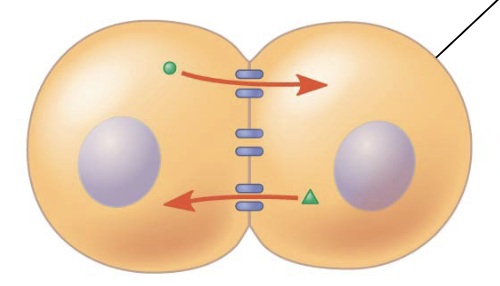
Which image describes plasmodesmata between plant cells?
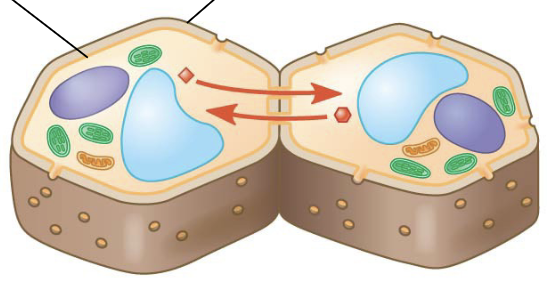
Which image describes cell-to-cell recognition?
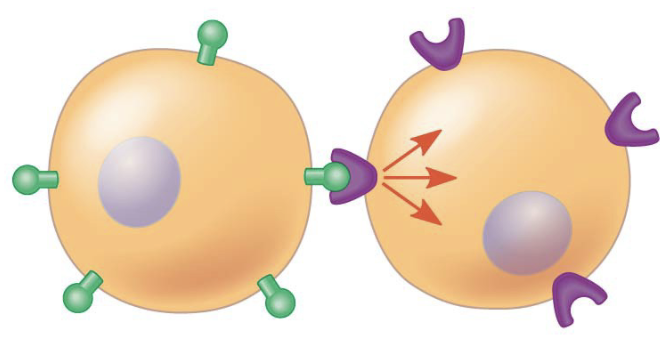
In other instances of local signaling, how else can animal cells communicate?
By secreting messenger molecules that travel only short distances
Growth Factors
These are the messenger molecules (usually proteins) carrying the signal. Their primary job is to tell a cell to either start growing in size or to undergo cell division (mitosis).
Local Regulators
This is the general term for signaling molecules that are released into the immediate vicinity of the cell that produced them and travel only short distances.
Growth factors are an example of _______?
local regulators in animal cells
Paracrine Signaling
Short-distance signaling or local chemical signaling
Synaptic Signaling
A specialized, fast, and precise form of paracrine signaling that occurs at the junction between two nerve cells (neurons), or between a neuron and a target cell (like a muscle or gland cell).
What is the best understood concept of local signaling in plants?
Communication between plasmodesmata
What chemical do plants and animals use in long distance signaling?
Hormones
Endocrine Signaling
Hormonal signaling in animals
How does endocrine signaling work?
Specialized cells release hormones which travel to target cells via the circulatory system.
The ability of a cell to respond to a signal depends on whether or not _________.
It has a receptor specific to that signal
Which image describes paracrine signaling?
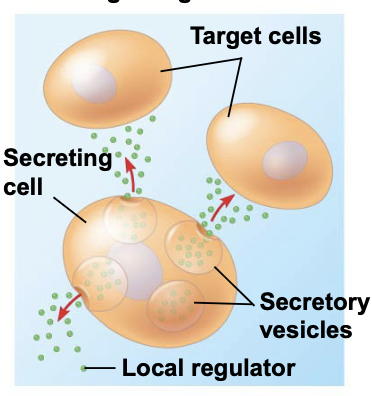
Which image describes synaptic signaling?
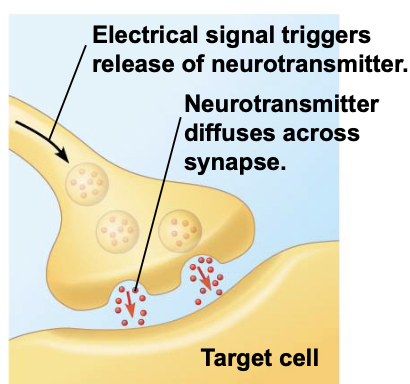
Which image describes endocrine (hormonal) signaling?
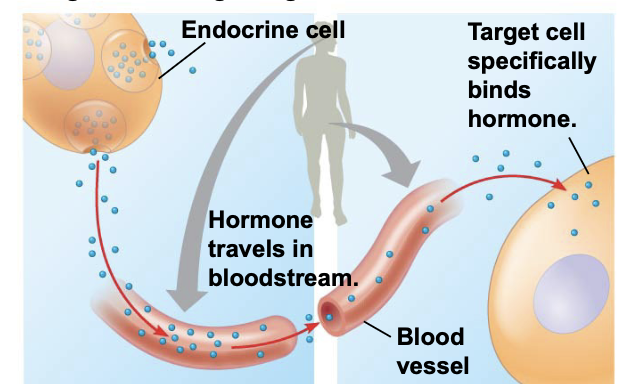
Who discovered how hormone epinephrine acts on cells?
Earl W. Sutherland
Epinephrine
(Also known as adrenaline) is a critical substance that acts as both a hormone and a neurotransmitter in the body.
What does Sutherland suggest the three stages of cell receiving signals are?
Reception
Transduction
Response
Reception Stage
The target cell detects a signaling molecule that binds to a receptor protein on the cell surface
Transduction Stage
The binding of the signaling molecule alters the receptor and initials a signal transduction pathway
Transduction is a process which often occurs in a ___________.
series of steps
Response Stage
The transduced signal triggers a specific response in the target cell
Which image describes the Reception Stage?

Which image describes the Transduction Stage?

Which image describes the Response Stage?

Ligand
A signal molecule which carries a message
The binding between a ligand and receptor is HIGHLY ___________.
specific
What determines whether or not a signal is able to react with a receptor?
If the shape of the receptor fits the signal shape.
What are most signal receptors?
Plasmamembrane proteins
G Protein-Coupled Receptors (GCPRs)
The largest family of cell-surface receptors, cell surface transmembrane receptors that work with the help of a G protein.
Were do most water-soluble signal molecules bind?
On specific sites on receptor proteins that span the plasma membrane.
What are the three main types of membrane receptors?
G protein-coupled receptors
Receptor tyrosine kinases
Ion channel receptors
What is the energy source that G proteins bind?
The energy-rich molecule GTP (Guanosine Triphosphate).
Describe the structure of G proteins.
They share a very similar basic structure across different systems (they are a highly conserved family of proteins).
Why are GPCRs so important?
They are extremely widespread and diverse in their functions, regulating nearly all physiological processes in the body.
Receptor Tyrosine Kinases (RTKs)
They are membrane receptors that attach phosphates to tyrosine amino acids (phosphorylation).
What is unique about an RTK's signaling capability?
It can trigger multiple signal transduction pathways at once (a key difference from GPCRs).
What critical diseases are associated with the abnormal functioning of RTKs?
Many types of cancers (due to their role in regulating cell growth and division).
What kind of receptor are RTKs?
Membrane receptors (spanning the cell membrane)
Ligand-gated Ion Channel Receptor
Acts a a gate when the receptor changes shape
What causes a Ligand-gated Ion Channel Receptor (LgICR) to open?
The binding of a signal molecule (ligand) to the receptor causes the receptor to change shape.
What is the main function of an LgICR?
To act as a gate (a controlled pore) in the cell membrane.
What specific substances are allowed through the channel gate?
Specific ions, such as Na+ (Sodium) or Ca2+ (Calcium).
What happens immediately after the ligand binds?
The gate opens, allowing specific ions to pass through the channel.
Which image describes a G protein-coupled receptor?
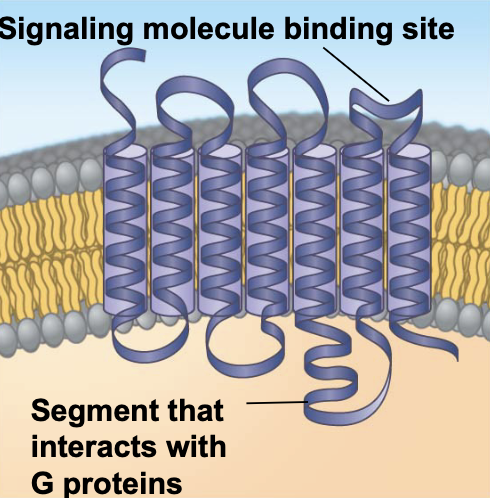
Which image describes Receptor Tyrosine Kinase Proteins?
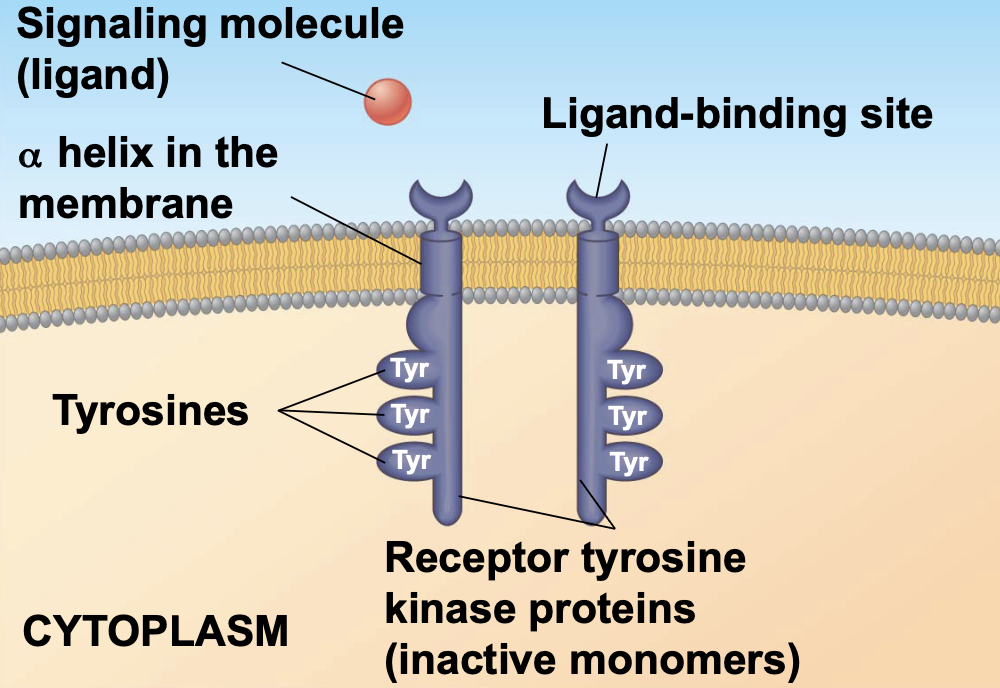
Which image describes a Ligand-gated ion channel receptor?
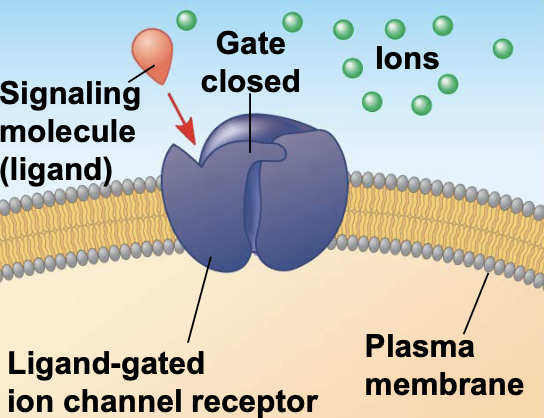
Intracellular Receptor Proteins
Proteins located inside the cell (in the cytoplasm or nucleus) that bind to small or hydrophobic ligands (like steroid and thyroid hormones) which can easily cross the cell membrane.
Where are intracellular receptor proteins found?
In the cytoplasm or nucleus of target cells.
What characteristic must chemical messengers have to activate these receptors?
They must be small or hydrophobic (lipid-soluble) to readily cross the cell membrane.
What are examples of these hydrophobic messengers?
Steroid and thyroid hormones of animals.
What is the function of an activated hormone-receptor complex?
It acts as a transcription factor, which turns on specific genes.
What is a defining characteristic of most signal transduction?
It typically involves multiple steps (a cascade) rather than a single event.
What happens to the signal strength as it goes through a multistep pathway
The signal is greatly amplified (a few ligand molecules can trigger a large cellular response).
Why is a multistep pathway better for a cell's response?
It provides more opportunities for the coordination and regulation of the cellular response.
What is the first step in the chain of molecular interactions?
The binding of a signaling molecule (ligand) to its receptor.
What analogy describes the relay of the signal?
Like falling dominoes—one protein activates the next in a sequence.
What happens to the signal at each step of the pathway?
The signal is transduced (converted) into a different form.
What form does this conversion usually take?
A shape change (conformational change) in the activated protein.
Phosphorylation
The addition of a phosphate group
Dephosphorylation
The removal of a phosphate group
Protein Kinases
Enzymes that catalyze the addition of a phosphate group from ATP to a protein, a process called phosphorylation.
Phosphorylation Cascade
A sequence of signaling pathway events where one enzyme phosphorylates and activates the next in the series, which then phosphorylates the next, and so on, until the final target protein is activated to carry out the cellular response.
Many relay molecules in signal transduction pathways are ___________.
Protein kinases
Which image describes a phosphorylation cascade?
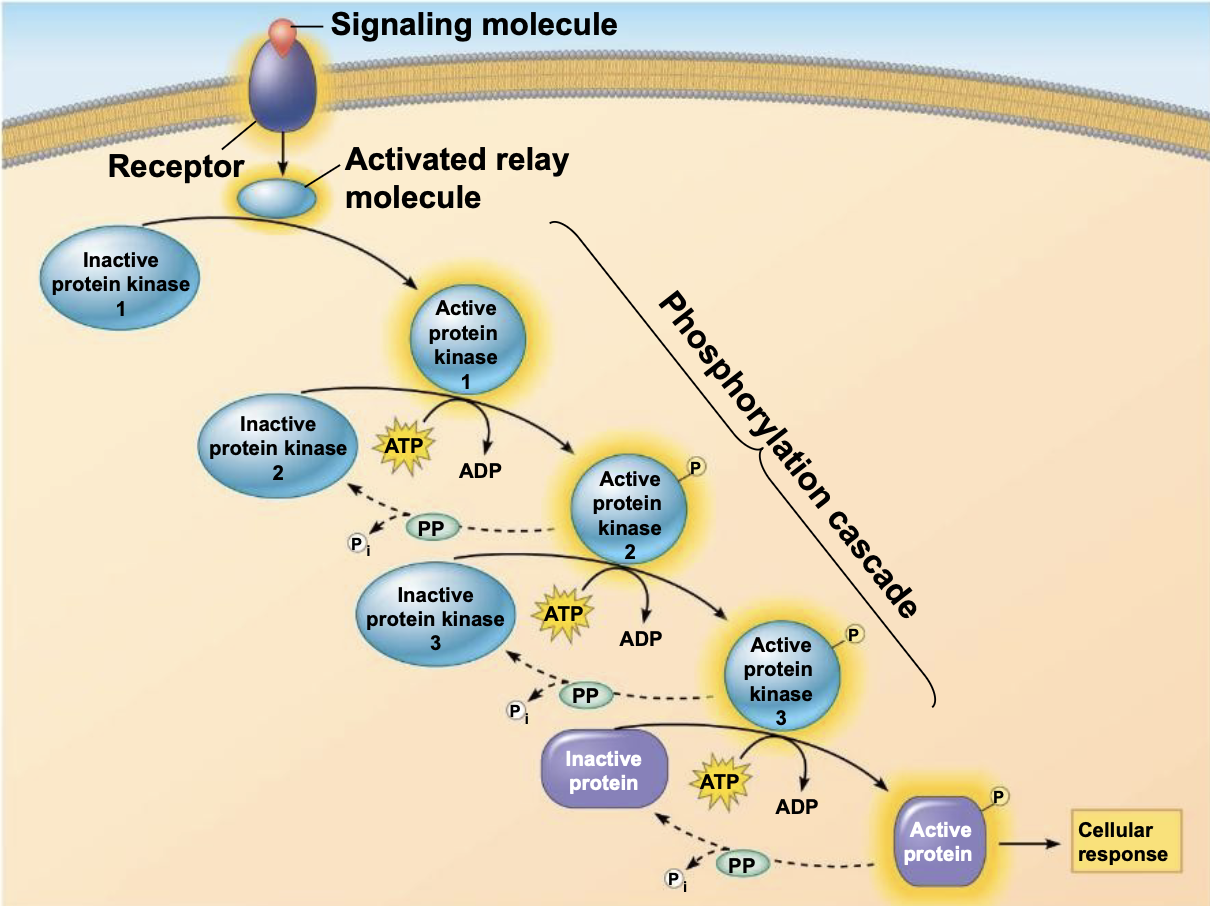
Protein Phosphatases
Enzymes that catalyze the removal of a phosphate group from a protein, a process called dephosphorylation.
Phosphorylation and dephosphorylation act as a ____________ turning activities on and off as required.
molecular switch
Many signaling pathways involve _____________.
Second messengers
Second Messengers
Small, nonprotein, water-soluble molecules or ions that spread throughout a cell by diffusion.
What initiates the pathways that second messengers participate in?
GCPRs and RTKs
Cyclic AMP (cAMP)
A non-protein, small, water-soluble molecule that relays a signal from a receptor on the cell surface into the cell's interior, often resulting in signal amplification and a diverse cellular response.
Name two common second messengers.
cAMP and calcium ions
Adenylyl Cyclase
An enzyme in the plasma membrane, converts ATP to cAMP in response to an extracellular signal
What molecules trigger the formation of cAMP?
Many signal molecules bind to their receptors (often GPCRs).
Name the three main protein components of the cAMP pathway.
G proteins, G protein-coupled receptors (GPCRs), and Protein Kinases.
What enzyme does cAMP usually activate, and what does that enzyme do?
It activates Protein Kinase A (PKA), which then phosphorylates various other proteins.